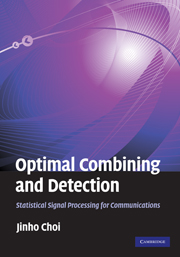Book contents
- Frontmatter
- Contents
- Preface
- List of symbols
- List of abbreviations
- 1 Introduction
- 2 Fundamentals of detection theory
- 3 Fundamentals of estimation theory
- 4 Optimal combining: single-signal
- 5 Array signal processing and smart antenna
- 6 Optimal combining: multiple-signal
- 7 Multiple signal detection in vector space: MIMO detection
- 8 MIMO detection with successive interference cancellation
- 9 Lattice-reduction-aided MIMO detection
- 10 Analysis of LR-based MIMO detection
- Appendix 1 Review of signals and systems
- Appendix 2 A brief review of entropy, mutual information, and channel capacity
- Appendix 3 Important properties of matrices and vectors
- Appendix 4 Lattice theory
- References
- Index
6 - Optimal combining: multiple-signal
Published online by Cambridge University Press: 05 July 2014
- Frontmatter
- Contents
- Preface
- List of symbols
- List of abbreviations
- 1 Introduction
- 2 Fundamentals of detection theory
- 3 Fundamentals of estimation theory
- 4 Optimal combining: single-signal
- 5 Array signal processing and smart antenna
- 6 Optimal combining: multiple-signal
- 7 Multiple signal detection in vector space: MIMO detection
- 8 MIMO detection with successive interference cancellation
- 9 Lattice-reduction-aided MIMO detection
- 10 Analysis of LR-based MIMO detection
- Appendix 1 Review of signals and systems
- Appendix 2 A brief review of entropy, mutual information, and channel capacity
- Appendix 3 Important properties of matrices and vectors
- Appendix 4 Lattice theory
- References
- Index
Summary
In various signal processing and communication applications, multiple signals can coexist and a receiver has to detect or estimate multiple signals (or possibly their features) simultaneously. For example, we can consider a multiple-speaker identification system that attempts to identify multiple speakers’ voices simultaneously. Another example is a multi-sensor system for multiple-signal classification in radar and sonar applications. The notion of signal combining in Chapter 4 can be extended to the case of multiple signals. Since other signals co-exist, the signal combiner plays a crucial role in not only combining multiple observations, but also mitigating the other signals.
In this chapter, we discuss optimal signal combining to estimate multiple signals simultaneously when multiple observations or received signals are available. Various well-known optimal combiners are introduced. In particular, we mainly focus on the MMSE combiner as it is widely used and has various crucial properties. In signal combining or estimation, no particular constraint on transmitted signals is imposed, while in Chapter 7 we will discuss signal detection (not estimation) for multiple signals under the assumption that each signal is an element of a signal alphabet or constellation, which becomes a crucial constraint in signal detection.
Systems with multiple signals
Suppose that there are K signal sources transmitting signals simultaneously through a common channel to a receiver as shown in Fig. 6.1. The signals generated from multiple sources could be correlated or not.
Information
- Type
- Chapter
- Information
- Optimal Combining and DetectionStatistical Signal Processing for Communications, pp. 143 - 175Publisher: Cambridge University PressPrint publication year: 2010
